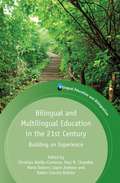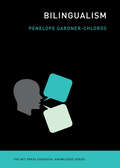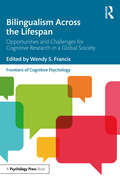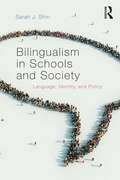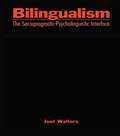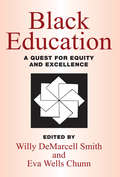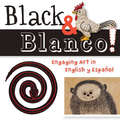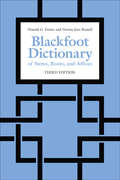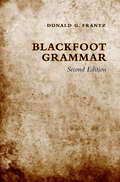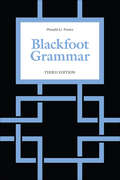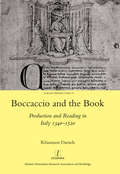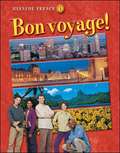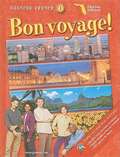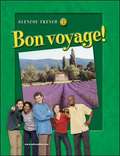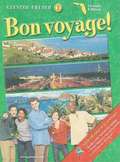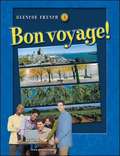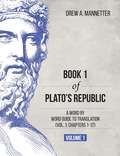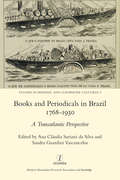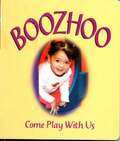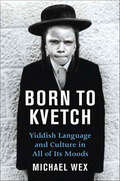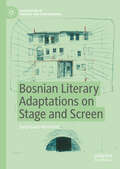- Table View
- List View
Bilingual and Multilingual Education in the 21st Century
by Christian Abello-Contesse Paul M ChandlerBilingual education is one of the fastest growing disciplines within applied linguistics. This book includes the work of 20 specialists working in various educational contexts across Europe, Latin America and North America to create a volume which is both comprehensive in scope and multidimensional in its coverage of current bilingual initiatives. The central themes of this volume, which draws on past experiences of bilingual education, include issues in language use in classrooms at elementary, secondary and tertiary levels; participant perspectives on bilingual education experiences; and the language needs of bi- and multilingual students in monolingual schools. This collection will be of interest to teachers and administrators in bi- and multilingual education programs, as well as scholars working in the field of language education.
Bilingualism (The MIT Press Essential Knowledge series)
by Penelope Gardner-ChlorosAll about bilingualism, in science and in life: the benefits and controversies, the individual experience, and the social significance.Nearly half the world's people are bilingual, but many have no clear understanding of what—aside from being fluent in more than one language—bilingualism means. This lively introduction by linguist Penelope Gardner-Chloros covers everything a bilingual (or curious monolingual) individual might want to know. The book discusses how bilingualism affects brain development and performance in the young and old, its social and political significance throughout time and around the globe, and how people experience and describe it. Gardner-Chloros looks at how both children and adults, become bilingual, how this affects learning, and what it means to be a bilingual family or family member. Drawing on the latest research, she offers a comprehensive but accessible account of the cognitive effects of bilingualism, and how the bilingual brain differs from the monolingual one. With the help of real examples, she outlines the impact of bilingualism on everyday speech and writing, from formal literature to social media, and lets speakers of various languages and backgrounds describe, in their own words, their experience of bilingualism and its impact on their lives. Informative, engaging, and wide-ranging, Bilingualism is the indispensable resource on a common but little understood phenomenon of far-reaching personal, social, political, and historical significance.
Bilingualism Across the Lifespan: Opportunities and Challenges for Cognitive Research in a Global Society (Frontiers of Cognitive Psychology)
by Wendy S. FrancisBilingualism Across the Lifespan explores the opportunities and challenges that are inherent in conducting cognitive research in an increasingly global and multilingual society. Divided into three sections, the book highlights the multifaceted and complex nature of bilingualism. The first section focuses on what every cognitive psychologist ought to know about bilingualism: the impact of bilingualism on cognition across the lifespan, the idea that bilinguals are not a special case, and the importance of bilingualism in cognitive research beyond language. The second section focuses on challenges inherent in bilingual research: diversity of bilingual experience, the assessment of proficiency, and finding matched comparison groups and materials. Finally, the book considers opportunities that are created when bilingualism is incorporated into the cognitive research enterprise. It illustrates how researchers of bilingualism leverage theory, methodology, and findings from single-language research, incorporate uniquely bilingual processes or representations, and target populations of bilinguals that help to establish universal properties. Bringing together leading international contributors, the book provides the reader with a better understanding of the nature of bilingualism and bilingual research as it relates to human cognition. It will be an essential read for all researchers and upper-level students of bilingualism and cognitive psychology more generally.
Bilingualism in Schools and Society: Language, Identity, and Policy
by Sarah J. ShinThis book is an introduction to the social and educational aspects of bilingualism. It presents an overview of a broad range of sociolinguistic and political issues surrounding the use of two languages, including code-switching in popular music, advertising, and online social spaces. It offers a well-informed discussion of what it means to study and live with multiple languages in a globalized world and practical advice on raising bilingual children.
Bilingualism in the Spanish-Speaking World
by Austin, Jennifer and Blume, María and Sánchez, Liliana Jennifer Austin María Blume Liliana SánchezBilingualism has given rise to significant changes in Spanish-speaking countries. In the US, the increasing importance of Spanish has engendered an English-only movement; in Peru, contact between Spanish and Quechua has brought about language change; and in Iberia, speakers of Basque, Galician and Catalan have made their languages a compulsory part of school curricula and local government. This book provides an introduction to bilingualism in the Spanish-speaking world, looking at topics such as language contact, bilingual societies, bilingualism in schools, code-switching, language transfer, the emergence of new varieties of Spanish, and language choice - and how all of these phenomena affect the linguistic and cognitive development of the speaker. Using examples and case studies drawn primarily from Spanish/English bilinguals in the US, Spanish/Quechua bilinguals in Peru and Spanish/Basque bilinguals in Spain, it provides diverse perspectives on the experience of being bilingual in distinct cultural, political and socioeconomic contexts.
Bilingualism: The Sociopragmatic-Psycholinguistic Interface
by Joel WaltersIn the past 30 years, the study of bilingualism processing has been conducted independently by two fields, psycholinguistics and sociolinguistics. This volume merges these two fields, addressing one of the tough problems dividing researchers in bilingualism, conceptually as well as methodologically. Joel Walters proposes a new approach to bilingualism processing--the Sociopragmatic-Psycholinguistic (SPPL) Model--which presents language as a social phenomenon. The author accomplishes this by identifying and organizing evidence from a wide range of linguistic disciplines, merging sociopragmatics, discourse analysis, and ethnography with social cognition, psycholinguistics, and neuroscience. By extension, the author offers convincing explanations of how related fields can profit from a comprehensive bilingual processing model. As a result, Joel Walters delivers a well-organized, comprehensive model that is thought through at every level. This book appeals to graduate students, scholars in the fields of linguistics, bilingualism, second language acquisition, psycholinguistics, and sociolinguistics. It is useful to researchers for its comprehensiveness and methodological acumen and may be appropriate as a supplementary textbook for graduate-level courses in bilingualism or for seminars on similar topics.
Black Education: A Quest for Equity and Excellence
by Willy DeMarcell Smith Eva Wells ChunnThis highly focused collection of papers, commissioned by the National Urban League, offers a candid and courageous portrait of black education in transition. This is a period, as the editors note in their opening remarks, that is characterized by a huge shift from federal responsibility for minority education to authority and autonomy being lodged at the local government level. Further, many institutions that once worked well, no longer do so. Many ambitious social programs and policies that originally promised much, have been abandoned, have failed, or just faded away. Pivotal to these times and changes is the question of the extent to which the American educational system has been, or still is, capable of being responsive to incorporating and even instigating equity and excellence for black Americans. This volume asks the hard questions: is the educational system geared up for the maintenance of anything other than mainstream values? can it adapt to minority youth requirements? when, why, and how do educational policies of majorities and minorities clash? How are priorities to be established on the basis of wealth or need? The legal statutes and administrative enforcement of equal educational opportunities are explored in depth and with a deep compassion for all parties involved.
Black and Blanco!
by San Antonio Museum of ArtWhat better way to be introduced to the contrasting interplay between black and white than with eye-catching works of art. This bi-lingual edition also introduces children at a young age to both English and Spanish.Art for this book was selected from the collection of the San Antonio Museum of Art, one of the leading art museums in the United States with a collection spanning a broad range of history and world cultures.
Blackfoot Dictionary of Stems, Roots, and Affixes: Third Edition
by Norma Jean Russell Donald FrantzThe Blackfoot Dictionary is a comprehensive guide to the vocabulary of Blackfoot, an Algonquian language spoken by thousands in Alberta and Montana. This third edition of the critically acclaimed dictionary adds more than 1,100 new entries, major additions to verb stems, and the inclusion of vai, vii, vta, and viti syntactic categories. It contains more than 5,500 Blackfoot-English entries and an English index of more than 6,000 entries, and provides thorough coverage of cultural terms. The transcription uses an official, technically accurate alphabet and the authors have classified entries and selected examples based on more than 46 years of research.
Blackfoot Grammar
by Donald G. FrantzThousands of people in Alberta and Montana speak Blackfoot, an Algonquian language. But the numbers are diminishing and the survival of Blackfoot is in some danger. To help preserve the language while it is still in daily use, Donald G. Frantz and Norma Jean Russell collaborated on the Blackfoot Dictionary, published in 1989 to widespread acclaim and later revised in 1995. Blackfoot Grammar, the companion volume to the dictionary, has now also been updated with a second edition. The changes made to each chapter reflect new approaches refined through years of teaching experience. New chapters on 'Numbers and Enumeration' and 'Translating from English to Blackfoot' have been added, as well as new exercises and two new appendixes describing the phonetics of Blackfoot and the design of the alphabet.This second edition of Blackfoot Grammar will be a welcome update not only for those who wish to learn the language, but for all those with an interest in Native Studies and North American linguistics.
Blackfoot Grammar: Third Edition
by Donald G. FrantzAlthough thousands of people in Alberta and Montana speak Blackfoot, an Algonquian language, their numbers are diminishing and the survival of Blackfoot is in danger. Blackfoot Grammar, the companion volume to The Blackfoot Dictionary of Stems, Roots and Affixes Third Edition, provides description and analyses of the major features of Blackfoot grammar and language structures. The changes throughout this third edition reflect approaches refined through years of teaching experience. A new appendix, featuring a lengthy Blackfoot text with interlinear English translation has been added, as well as numerous corrections and additions to every chapter. This third edition of Blackfoot Grammar will be a welcome resource not only for those who wish to learn the language, but for all those with an interest in Native Studies and North American linguistics.
Blended Language Program Evaluation
by Paul Gruba Mónica S. Cárdenas-Claros Ruslan Suvorov Katherine RickAdvocating an argument-based approach, Blended Language Program Evaluation presents a framework for planning, conducting, and appraising evaluation of blended language learning across three institutional levels, and demonstrates its utility and application in four case studies carried out in diverse international contexts.
Boccaccio and the Book: Production and Reading in Italy 1340-1520
by Rhiannon DanielsAs a new digital era increasingly impacts on the 'age of print', we are ever more conscious of the way in which information is packaged and received. The influence of the material form on the reading process was no less important during the gradual shift from manuscript to early print culture. Focusing on the physical structure and presentation of manuscripts and printed books containing texts by one of the most influential authors of the medieval period, Rhiannon Daniels traces the evolving social, cultural, and economic profile of Boccaccio's readership and the scribes and printers who laboured to reproduce three of his works: the Teseida , Decameron , and De mulieribus claris . Rhiannon Daniels is a British Academy Postdoctoral Fellow in the Department of Italian at the University of Leeds.
Bon Voyage! Glencoe French 1
by Conrad J. Schmitt Katia Brillié LutzBon voyage! Clearly the best choice! Bon voyage!(Schmitt and Brillié Lutz) is a comprehensive program that encourages meaningful, practical communication by immersing your students in the language and culture of the Francophone world. The text and its complementary resources help you meet the needs of every student in your diverse classroom. Bon voyage!provides your itinerary for successwith exposure to the Francophone culture; clear expectations and goals; thematic, contextualized vocabulary; useful and thematically-linked structure; progressive practice; real-life conversation; cultural readings in the target language; recycling and review; and exquisite National Geographic Society panoramas of the Francophone world.
Bon Voyage! Glencoe French 1 (Florida)
by Conrad J. Schmitt Katia Brillié LutzBon voyage!Clearly the best choice!Bon voyage!(Schmitt and Brillié Lutz) is a comprehensive program that encourages meaningful, practical communication by immersing your students in the language and culture of the Francophone world. The text and its complementary resources help you meet the needs of every student in your diverse classroom.Bon voyage!provides your itinerary for success with exposure to the Francophone culture; clear expectations and goals; thematic, contextualized vocabulary; useful and thematically-linked structure; progressive practice; real-life conversation; cultural readings in the target language; recycling and review; and exquisite National Geographic Society panoramas of the Francophone world.
Bon Voyage! Glencoe French 2
by Conrad J. Schmitt Katia Brillié LutzBon voyage is a comprehensive program that encourages meaningful, practical communication by immersing your students in the language and culture of the Francophone world. The text and its complementary resources help you meet the needs of every student in your diverse classroom.Level 2continues with chapters 13 and 14 from Level 1 as chapters 1 and 2. Révision A-F reviews vocabulary, conversation, and structure. Teachers have the flexibility to review what their students require.Bon voyage!provides your itinerary for success with exposure to the Francophone culture; clear expectations and goals; thematic, contextualized vocabulary; useful and thematically-linked structure; progressive practice; real-life conversation; cultural readings in the target language; recycling and review; and exquisite National Geographic Society panoramas of the Francophone world.
Bon Voyage! Glencoe French 2 (Florida)
by Conrad J. Schmitt Katia Brillié LutzBon voyage!Clearly the best choice!Bon voyage!(Schmitt and Brillié Lutz) is a comprehensive program that encourages meaningful, practical communication by immersing your students in the language and culture of the Francophone world. The text and its complementary resources help you meet the needs of every student in your diverse classroom.Level 2continues with chapters 13 and 14 from Level 1 as chapters 1 and 2.Révision A-Freviews vocabulary, conversation, and structure. Teachers have the flexiblity to review what their students require.Bon voyage!provides your itinerary for successwith exposure to the Francophone culture; clear expectations and goals; thematic, contextualized vocabulary; useful and thematically-linked structure; progressive practice; real-life conversation; cultural readings in the target language; recycling and review; and exquisiteNational Geographic Societypanoramas of the Francophone world.
Bon Voyage! Glencoe French 3
by Conrad J. Schmitt Katia Brillié LutzBon voyage!Clearly the best choice!Bon voyage!(Schmitt and Brillié Lutz) is a comprehensive program that encourages meaningful, practical communication by immersing your students in the language and culture of the Francophone world. The text and its complementary resources help you meet the needs of every student in your diverse classroom.Bon voyage!provides your itinerary for successwith exposure to the Francophone culture; clear expectations and goals; thematic, contextualized vocabulary; useful and thematically-linked structure; progressive practice; real-life conversation; cultural readings in the target language; recycling and review; and exquisiteNational Geographic Societypanoramas of the Francophone world.
Bon Voyage! Glencoe French 3
by Conrad J. Schmitt Katia Brillié LutzWith this text, teachers can select the material they present in depth based on the abilities, needs, and interests of their students. The text is divided into eight chapters that adhere to a very general theme as indicated in the chapter title--Les voyages, La santé, etc. Each chapter contains short lessons on Culture, Conversation, Language, Review Grammar, Journalism, Advanced Grammar, and Literature.
Book 1 of Plato's Republic: A Word by Word Guide to Translation (Vol. 1: Chapters 1-12)
by Drew A. MannetterVolume 1 of this new grammatical reader on the first 12 chapters of Book 1 of Plato’s Republic is the most thorough of available resources, designed for students who have only basic skills as well as those at a more advanced level. The text is complete and not adapted; no difficult passages are excised. The running vocabularies are complete, providing the reader context specific meanings. The text is broken down into sentences, providing a manageable amount of material, and space is provided for translation after each sentence. Every construction and word is discussed in detail and referenced to Smyth’s Greek Grammar for further explanation. The details of the text, accents, conjunctions, adverbs, and particles, are not minimized but receive thorough treatment as well. The presentation allows for beginning students to make thorough use of the notes while more advanced students are able to consult the notes only when necessary and thus build up speed in translation.°Special features include:°°1) Complete, unadapted text.°2) Full running vocabulary; no words are omitted.°3) Every word is discussed; none are omitted.°4) Every construction is discussed; none are omitted.°5) All particles are explained; none are omitted.°6) Every word and construction is cross referenced to Smyth’s Greek Grammar for further explanation.°7) Room is provided after each sentence for translation.°8) Accentuation, where challenging, is discussed.
Book of Poems: A Dual-Language Book (Dover Dual Language Spanish)
by Federico García Lorca Stanley AppelbaumThe passionate life and violent death of Federico Garcia Lorca (1898-1936) retain an enduring fascination for readers around the world. Murdered by Nationalists at the outset of the Spanish Civil War, Lorca died at the peak of his creative powers. He remains his country's most widely translated writer, surpassed only by Cervantes in terms of critical commentary.This selection includes 55 of the 68 poems that comprised Lorca's 1921 Libro de poemas, all of them in their entirety and in their original sequence. Imbued with the spirit and folklore of the poet's native Andalusia, these verses feature the most complex spiritual content of any of Lorca's works. Editor Stanley Appelbaum provides sensitive, accurate English translations on the pages facing the original Spanish, as well as an informative introduction to the author's life and oeuvre, plus notes on the individual poems. An outstanding resource for students and teachers of Spanish language and literature, this compilation will enchant any lover of poetry.
Books and Periodicals in Brazil 1768-1930
by AnaClaudiaSurianiDa SilvaBefore the Portuguese Royal Court moved to its South-American colony in 1808, books and periodicals had a very limited circulation there. It was only when Brazilian ports were opened to foreign trade that the book trade began to flourish, and printed matter became more easily available to readers, whether for pleasure, for instruction or for political reasons. This book brings together a collection of original articles on the transnational relations between Brazil and Europe, especially England and France, in the domain of literature and print culture from its early stages to the end of the 1920s. It covers the time when it was forbidden to print in Brazil, and Portugal strictly controlled which books were sent to the colony, through the quick flourishing of a transnational printing industry and book market after 1822, to the shift of hegemony in the printing business from foreign to Brazilian hands at the beginning of the twentieth century. Sandra Guardini Vasconcelos is Professor of English and Comparative Literature at the University of Sao Paulo.
Boozhoo: Come Play With Us
by Fond Du Lac Head Start Program StaffThis is a delightful picture book which invites children to play together. It also includes a pronunciation guide.
Born to Kvetch: Yiddish Language and Culture in All Its Moods
by Michael Wex“Wise, witty and altogether wonderful. . . . Mr. Wex has perfect pitch. He always finds the precise word, the most vivid metaphor, for his juicy Yiddishisms.” —William Grimes, The New York TimesAs the main spoken language of the Jews for more than a thousand years, Yiddish has had plenty to lament, plenty to conceal. Its phrases, idioms, and expressions paint a comprehensive picture of the mind-set that enabled the Jews of Europe to survive a millennium of unrelenting persecution: they never stopped kvetching—about God, gentiles, children, food, and everything (and anything) else. They even learned how to smile through their kvetching and express satisfaction in the form of complaint.In Born to Kvetch, Michael Wex looks at the ingredients that went into this buffet of disenchantment and examines how they were mixed together to produce an almost limitless supply of striking idioms and withering curses (which get a chapter all to themselves). Born to Kvetch includes a wealth of material that’s never appeared in English before. You’ll find information on the Yiddish relationship to food, nature, divinity, humanity and even sex.This is no bobe mayse (cock-and-bull story) from a khokhem be-layle (idiot, literally a “sage at night” when no one’s looking), but a serious yet fun and funny look at a language that both shaped and was shaped by those who spoke it. From tukhes to goy, meshugener to kvetch, Yiddish words have permeated and transformed English as well.“This treasure trove of linguistics, sociology, history and folklore offers a fascinating look at how, through the centuries, a unique and enduring language has reflected an equally unique and enduring culture.” —Publishers Weekly, starred review
Bosnian Literary Adaptations on Stage and Screen (Adaptation in Theatre and Performance)
by Sanja Garić-KomnenićBosnian Literature on Stage and Screen aims to reconcile theoretical approaches with theatrical and cinematic practices by examining two adaptations based on works by the Bosnian author Meša Selimović. The book is informed by scholarship in film and theatre adaptation theories, and is grounded in a comparative approach that focuses on the interplay of sign systems and codes unique to screen and stage. The book looks closely at two adaptations: a screen adaptation of the novel The Fortress and a stage adaptation of the novel The Island.
